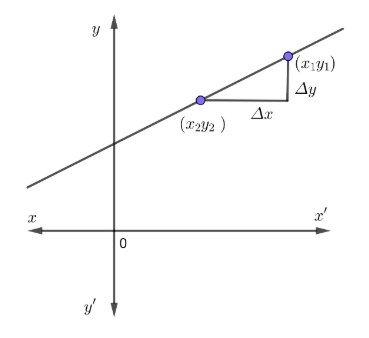
The parallelism condition for two straight lines one of which is specified by the equation $ax+by+c=0$ the other being represented parametrically by $x=\alpha t+\beta ,y=\gamma t+\delta $ is given by
(a) $\alpha \gamma -b\alpha =0,\beta =\delta =c=0$
(b) $a\alpha -b\gamma =0,\beta =\delta =0$
(c) $a\alpha +b\gamma =0$
(d) $a\gamma =b\alpha =0$
Answer
522.6k+ views
Hint: Use parametric equations to find the straight line. Take the slope of both equations to form the required equation.
Given lines are $ax+by+c=0.................\left( 1 \right)$
$x=\alpha t+\beta ................\left( 2 \right)$
$y=\gamma t+\delta .............\left( 3 \right)$
One of the straight line specified is $ax+bx+c=0$
We have to find other straight line by using the equation (2) and (3)
So as to complete the parallelism condition; By cross multiplying:
$\begin{align}
& x=\alpha t+\beta \\
& y=\gamma t+\delta \\
& \dfrac{x}{y}=\dfrac{\alpha t+\beta }{\gamma t+\delta } \\
& \Rightarrow x\left( \gamma t+\delta \right)=y\left( \alpha t+\beta \right) \\
\end{align}$
Divide throughout by $t$
\[\begin{align}
& \dfrac{x\left( \gamma t+\delta \right)}{t}=\dfrac{y\left( \alpha t+\beta \right)}{t} \\
& \Rightarrow \gamma \alpha +\dfrac{\delta x}{t}=\alpha y+\dfrac{\beta y}{t} \\
\end{align}\]
$\Rightarrow \left( \gamma x-\alpha y \right)+\left( \dfrac{\delta x}{t}-\dfrac{\beta y}{t} \right)=0...................\left( 4 \right)$
Slope ${{m}_{1}}=\alpha =\dfrac{{{a}_{1}}}{{{b}_{1}}}=\dfrac{x}{t},$ for equation (1)
Slope ${{m}_{2}}=\gamma =\dfrac{{{a}_{2}}}{{{b}_{2}}}=\dfrac{y}{t}$ , for equation (2)
Substituting the slope on equation (4)
${{\gamma }_{x}}-\alpha y+\alpha \delta -\gamma \beta =0...............\left( 5 \right)$
The equation (5) is the 2nd straight line to fulfil parallelism condition.
$ax+by+c=0$
$\gamma x-\alpha y+\alpha \delta -\gamma \beta =0$ (Equation 5)
$\therefore $ The required equation is found from the slope of the equation.
From this by considering that the slope of both the equations are similar i.e., now comparing the common equation and equation (5).
$\begin{align}
& ax+by+c=0 \\
& \gamma x-\alpha y+\alpha \delta -\gamma \beta \\
& here\text{ }{{\text{a}}_{1}}=a\text{ }{{\text{a}}_{2}}=\gamma \\
& \text{ }{{\text{b}}_{1}}=a\text{ }{{\text{b}}_{2}}=\alpha \text{ } \\
\end{align}$
We can consider that
\[\dfrac{{{a}_{1}}}{{{a}_{2}}}=\dfrac{{{b}_{1}}}{{{b}_{2}}}\Rightarrow \dfrac{a}{\gamma }=\dfrac{b}{-\alpha }\]
Now cross multiplying them we get,
\[-a\alpha =b\gamma \Rightarrow a\alpha +b\gamma =0\]
Thus we received the required equation.
So option C is correct.
Note: The slope of a line characterizes the direction of a line. In this question it is important to find the slope to fulfil the conditions of parallelism.
To find the slope, you need to divide the difference of $y$-coordinate of two points on a line by the difference of the $x$-coordinate of those same two points.
$\therefore slope=\dfrac{{{y}_{2}}-{{y}_{1}}}{{{x}_{2}}-{{x}_{1}}}$

Or, slope can be found also using
$\Delta $ Notation,
$y$-coordinate $=\Delta y$
$x$-coordinate $=\Delta x$
$\therefore slope=\dfrac{\Delta y}{\Delta x}$
$\dfrac{\Delta y}{\Delta x}=\dfrac{{{y}_{2}}-{{y}_{1}}}{{{x}_{2}}-{{x}_{1}}}=$slope of line
Given lines are $ax+by+c=0.................\left( 1 \right)$
$x=\alpha t+\beta ................\left( 2 \right)$
$y=\gamma t+\delta .............\left( 3 \right)$
One of the straight line specified is $ax+bx+c=0$
We have to find other straight line by using the equation (2) and (3)
So as to complete the parallelism condition; By cross multiplying:
$\begin{align}
& x=\alpha t+\beta \\
& y=\gamma t+\delta \\
& \dfrac{x}{y}=\dfrac{\alpha t+\beta }{\gamma t+\delta } \\
& \Rightarrow x\left( \gamma t+\delta \right)=y\left( \alpha t+\beta \right) \\
\end{align}$
Divide throughout by $t$
\[\begin{align}
& \dfrac{x\left( \gamma t+\delta \right)}{t}=\dfrac{y\left( \alpha t+\beta \right)}{t} \\
& \Rightarrow \gamma \alpha +\dfrac{\delta x}{t}=\alpha y+\dfrac{\beta y}{t} \\
\end{align}\]
$\Rightarrow \left( \gamma x-\alpha y \right)+\left( \dfrac{\delta x}{t}-\dfrac{\beta y}{t} \right)=0...................\left( 4 \right)$
Slope ${{m}_{1}}=\alpha =\dfrac{{{a}_{1}}}{{{b}_{1}}}=\dfrac{x}{t},$ for equation (1)
Slope ${{m}_{2}}=\gamma =\dfrac{{{a}_{2}}}{{{b}_{2}}}=\dfrac{y}{t}$ , for equation (2)
Substituting the slope on equation (4)
${{\gamma }_{x}}-\alpha y+\alpha \delta -\gamma \beta =0...............\left( 5 \right)$
The equation (5) is the 2nd straight line to fulfil parallelism condition.
$ax+by+c=0$
$\gamma x-\alpha y+\alpha \delta -\gamma \beta =0$ (Equation 5)
$\therefore $ The required equation is found from the slope of the equation.
From this by considering that the slope of both the equations are similar i.e., now comparing the common equation and equation (5).
$\begin{align}
& ax+by+c=0 \\
& \gamma x-\alpha y+\alpha \delta -\gamma \beta \\
& here\text{ }{{\text{a}}_{1}}=a\text{ }{{\text{a}}_{2}}=\gamma \\
& \text{ }{{\text{b}}_{1}}=a\text{ }{{\text{b}}_{2}}=\alpha \text{ } \\
\end{align}$
We can consider that
\[\dfrac{{{a}_{1}}}{{{a}_{2}}}=\dfrac{{{b}_{1}}}{{{b}_{2}}}\Rightarrow \dfrac{a}{\gamma }=\dfrac{b}{-\alpha }\]
Now cross multiplying them we get,
\[-a\alpha =b\gamma \Rightarrow a\alpha +b\gamma =0\]
Thus we received the required equation.
So option C is correct.
Note: The slope of a line characterizes the direction of a line. In this question it is important to find the slope to fulfil the conditions of parallelism.
To find the slope, you need to divide the difference of $y$-coordinate of two points on a line by the difference of the $x$-coordinate of those same two points.
$\therefore slope=\dfrac{{{y}_{2}}-{{y}_{1}}}{{{x}_{2}}-{{x}_{1}}}$

Or, slope can be found also using
$\Delta $ Notation,
$y$-coordinate $=\Delta y$
$x$-coordinate $=\Delta x$
$\therefore slope=\dfrac{\Delta y}{\Delta x}$
$\dfrac{\Delta y}{\Delta x}=\dfrac{{{y}_{2}}-{{y}_{1}}}{{{x}_{2}}-{{x}_{1}}}=$slope of line
Recently Updated Pages
The correct geometry and hybridization for XeF4 are class 11 chemistry CBSE

Water softening by Clarks process uses ACalcium bicarbonate class 11 chemistry CBSE

With reference to graphite and diamond which of the class 11 chemistry CBSE

A certain household has consumed 250 units of energy class 11 physics CBSE

The lightest metal known is A beryllium B lithium C class 11 chemistry CBSE

What is the formula mass of the iodine molecule class 11 chemistry CBSE

Trending doubts
State the laws of reflection of light

One Metric ton is equal to kg A 10000 B 1000 C 100 class 11 physics CBSE

Difference Between Prokaryotic Cells and Eukaryotic Cells

How do I convert ms to kmh Give an example class 11 physics CBSE

Describe the effects of the Second World War class 11 social science CBSE

Which of the following methods is suitable for preventing class 11 chemistry CBSE




